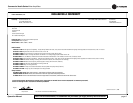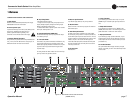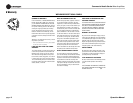
Commercial Audio Series Mixer-Amplifiers
page 11
Operation Manual
One DIP-switch selection enables Channel 1 as the priority input, which
mutes all other inputs to Amp 1. In the 280MA only, another DIP switch
selection enables Channel 5 as the priority input, which mutes all other
inputs to Amp 2. In the 280MA only, another set of DIP switches enable
Channel 1 as the priority input into both Amp 1 and Amp 2, effectively
muting any input.
To set the mixer-amplifier for normal mode with no priority:
Set the AMP CONFIG DIP switch as follows:
1 ON
2 OFF
3 OFF
4 OFF
5 ON
6 OFF
To give priority to the Channel-1 input in Amp 1 only:
Set the AMP CONFIG DIP switch as follows:
1 OFF
2 ON
3 OFF
4 OFF
Also, wire a SPST switch to the PRIORITY connector between COM and
CH 1 AMP 1. Close the switch when you want the Channel-1 input to
mute all other inputs feeding Amp 1.
To give priority to the Channel-5 input in Amp 2 only:
Set the AMP CONFIG DIP switch as follows:
5 OFF
6 ON
Also, wire a SPST switch to the PRIORITY connector between COM and
CH 5 AMP 2. Close the switch when you want the Channel-5 input to
mute all other inputs feeding Amp 2.
2.6 Input Routing
In the 280MA, any input can be assigned to Amp 1, Amp 2 or both. The
two DIP switches labeled INPUT ROUTING are used (Figure 2.8). Follow
the settings printed on the back panel next to the INPUT ROUTING switch.
For example, to send input Channel 3 to Amp 1 and Amp 2, turn on DIP
switches 13 and 14.
2.7 Phantom Power
To turn on phantom power on all mic inputs, turn on the switch number 7
in the AMP CONFIG DIP switch.
2.8 Priority Muting
A back-panel AMP CONFIG DIP switch (Figure 2.9) can assign Input Ch.
1 or Input Ch. 5 as the priority input for each amplifier output, which tem-
porarily mutes the remaining inputs. Muting is activated by contact clo-
sures.
For example, suppose you configured Channel 1 as the priority input. Mic
1 is plugged into Channel 1. A press-to-talk switch in Mic 1 is wired to
the Priority connector in the mixer-amplifier. When you press the mic
switch, all other signals are muted so you can make an announcement on
Mic 1.
Figure 2.8 Input Routing DIP Switches
Figure 2.9 AMP CONFIG DIP Switch
To give priority to the Channel-1 input in Amp 1 and Amp 2:
Set the AMP CONFIG DIP switch as follows:
1 OFF
2 ON
3 ON
4 ON
Also, wire a SPST switch to the PRIORITY connector between COM and
CH1 AMP 1. Close the switch when you want the Channel-1 input to
mute all other inputs feeding Amp 1 and Amp 2.
Note: The routing configuration is extremely versatile. Many configura-
tions for additional applications not highlighted in this document can be
created by examining the signal flow in the block diagram on page 13.
2.9 Link In/Out Switches
These switches (Figure 2.10) affect which signals are heard when another
mixer is wired to the mixer-amplifier. One switch is included per amplifier
channel.
IN: Any signal applied to the AMP INPUT connector will be mixed with
the input signal(s).
OUT: Only the signal from the AMP INPUT connector will appear at the
amplifier output.
How to link another mixer to your mixer-amplifier:
Connect the extra mixer’s LINE OUT connector to the mixer-amplifier’s
AMP INPUT connector. Set the Link switch to IN.
How to set up Music-On-Hold output:
Connect mixer-amp LINE OUT to Music-On-Hold input on telephone
system interface/PBX. Set the LINK SWITCH to IN.
How to set up a processing loop:
Connect mixer-amp LINE OUT to processor input. Connect processor
output to mixer-amp AMP INPUT connector. Set the Link switch to OUT.
Figure 2.10
Link In/Out Switches


















